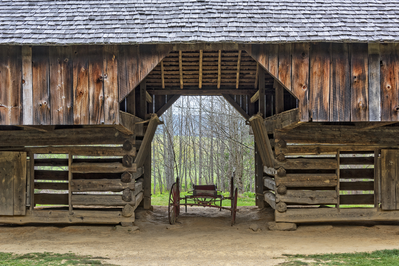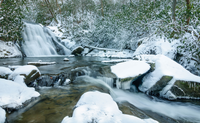Surely you’ve heard of Cades Cove. It’s one of the most popular destinations in Great Smoky Mountains National Park. This serene and historic valley is a place where time sits still and visitors get lost in its picturesque setting! But beneath today’s beauty is the fascinating legacy of those who used to call Cades Cove home. The first European settlers arrived in the early 1800s and would quickly face challenges of self-reliance, community building, and making the most of the land. Learn more about their story as we provide a glimpse into pioneer life in Cades Cove:
Clearing & Building From Scratch

Around the 1820s the first European settlers arrived at what is now Cades Cove to find a valley covered in thick hardwood and pine forests. To make room for their homes and crops, they felled trees and removed rocks, requiring back-breaking work to turn the wilderness into farmland. The construction of cabins, barns, smokehouses, and grist mills was carried out by hand, using giant logs cut by primitive tools.
Faith, Education & Community
As the population of Cades Cove grew, the need for community institutions became apparent. Cades Cove churches were established and quickly became cornerstones of the community. Log schoolhouses were built allowing local children to learn from close to home. These schools provided more than just education. They became places that fostered collective decision-making, social bonds, and a local identity in the remoteness of the Smokies.
Farming & Milling in Cades Cove

The livelihood of the early pioneers in Cades Cove depended on subsistence farming. They grew corn and wheat while also raising livestock like cattle, chickens, and hogs. To supplement their harvest, they would hunt deer, bear, and small game, rely on catching trout in nearby streams, and collect wild nuts and berries. When John P. Cable Grist Mill was built around 1870 it proved to be a game-changer as the community no longer had to make long treks to grind their grain.
From Log Cabins to Barns
The early settlers in Cades Cove built simple, functional log homes. By the 1840s some families experimented with building framed-style houses, but many reverted back to log cabins after the Civil War, valuing simplicity and tradition. Special structures like cantilever barns featured overhanging upper levels for storing hay with shelter available underneath, reflecting their ingenuity in meeting their agricultural needs.
Work, Worship & Celebration

A typical day in early Cades Cove looked something like this: farm chores at dawn, milking, more chores, tending the fields, and evenings spent at the church, grist mill, or neighbor’s cabins. After a day of hard work, evenings usually included activities like music, prayer, and storytelling. Holidays and barn raisings provided an opportunity to celebrate, dance, and unite with fellow community members.
Resistance & Land Transition
In the process of Great Smoky Mountains National Park being established, Tennessee and North Carolina began purchasing land in Cades Cove. Some families sold willingly, but others, like John W. Oliver resisted. Oliver even took them to court, and eventually stayed on his property until 1937. Oliver’s cabin stands to this day in Cades Cove.
Cades Cove Preservation Efforts

Today, Cades Cove Loop Road allows guests to see a variety of historic structures in the area. These well-preserved buildings include homesteads, barns, churches, and of course the grist mill. As you explore these structures, you’ll feel as if you’re traveling back in time to the days of the earliest settlers in Cades Cove. Each of them tell a story of resilience, faith, community, culture, and innovation.
Now that you know a bit more about pioneer life in Cades Cove it’s time to visit to experience it for yourself! Historic structures and natural beauty aren’t the only things you’ll find here. Discover what Cades Cove wildlife you might spot on your visit!








